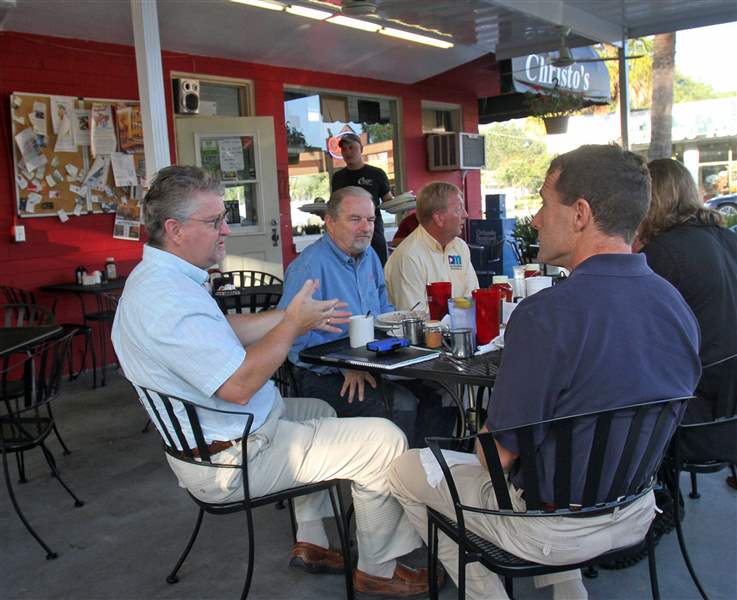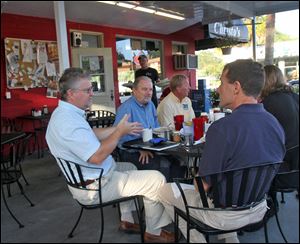
Group hopes to build affordable, all-made-in-America homes
10/7/2012
Gary Rackliff, left, V.P. Build the U.S., gestures to Dudley Powell, right, as building professionals meet for breakfast in Orlando, Florida, to plan US-made houses and a related web site.
MCT

Gary Rackliff, left, V.P. Build the U.S., gestures to Dudley Powell, right, as building professionals meet for breakfast in Orlando, Florida, to plan US-made houses and a related web site.
ORLANDO, Fla. — Wisps of steam waft upward from coffee mugs, and renderings of a home are propped up, on an outdoor table at Christo’s Cafe in Orlando one recent Wednesday morning.
Seated around the table are seven men and one woman talking about Little League baseball, rainstorms, and the common cause that unites them at least once a week: With backgrounds in construction, home design, video automation, and product sales, the group’s members are launching a nearby “show home” and a Web site both aimed at promoting made-in-America construction products.
“I’m not doing it just because I’m passionate about doing it,” said Jon Pleveich, owner of Orlando-based Southern Traditions Development Inc. “I’m doing it to be profitable. … If we could do it for a certain price, I think a lot of builders will follow suit.”
Mr. Pleveich is spending about $300,000 on construction and a building lot on nearby Helen Avenue. The goal: Build a 2,400-square-foot house that consists almost entirely of U.S.-made material and is affordable, energy-efficient, and easily replicated. The price of the four-bedroom home, which should be completed in about a year, may be in the low $400,000s. The electric bills, Mr. Pleveich said, will likely be less than $200 a month.
The Christo’s breakfast club, which has no formal name, has also developed a Web site that features a searchable database of home products manufactured in the United States. In addition to products, the Web site, www.buildtheus.com, also markets home-construction services.
Around the wrought-iron table on Christo’s patio this particular morning, the team discusses how they can ensure that subcontractors adhere to the made-in-America mission.
The group’s American-made version of the American Dream got its start in December, 2011, when Dudley Powell, an Orlando-based products distributor, opened an email video attachment of an ABC News segment about builder Anders Lewendal’s attempt to build a home in Montana using all U.S. products and workers.
“I saw it and I pretty much was immediately inspired and sent it to everyone I could. But what I was concerned about was that it would die,” said Mr. Powell, vice president of Bentley Sales. “In my mind, it could have died — the movement, the ability of people to find out about this home and get involved. … How many times have you seen great news and then life goes on. I kept thinking: ‘There’s got to be something more to do.’”
Mr. Powell enlisted the help of Gary Rackliff, a computer-animation professional who put together the group’s Web site. Then Lucia became interested in the idea and brought in several others.
The project got a further boost in January when the International Builder Show came to Orlando. Mr. Powell said he exhausted himself stopping at hundreds of booths to talk to businesses tied to home construction. That exhibit-floor tour helped him add more companies to the Web site list of contacts for products made on U.S. soil.
In May, the group got some added momentum with news that Orlando residents Greg and Jennifer Gent were using only U.S. products to construct a house in the city’s Conway area.
Both the Gents and the Christo’s group say they have detected an increased appetite among Americans to support manufacturing jobs in this country.
The loss of U.S. jobs in the home-building business has been a gradual process, Mr. Powell said. “I think we got lazy. For one, we just quit researching where products were made,” he said. “The international market changed so quickly, and there were good products being offered from around the world.”
Higher wages sought by U.S. unions and higher taxes levied by the federal government have raised the cost of manufacturing in this country, Mr. Powell said, sending many jobs overseas in a process known as “offshoring.” But the pendulum, he added, is beginning to swing back, as countries such as China wrestle with new regulations designed to lessen pollution. Mr. Powell cited as an example the relocation of jobs from China to the U.S. by HB&G Cos., an Alabama-based column manufacturer that his family helped found in the 1880s.
With the coffee mugs drained and only a few remnants of eggs and toast left on a couple of plates, the men and woman pushed their chairs back from the table at Christo’s. They had talked about ways to showcase sponsored products for the house on the new Web site, the potential to use interior-design elements manufactured in this country, and opportunities to replicate the Helen Avenue house elsewhere in the area.
Next week, if not sooner, they’ll be back.